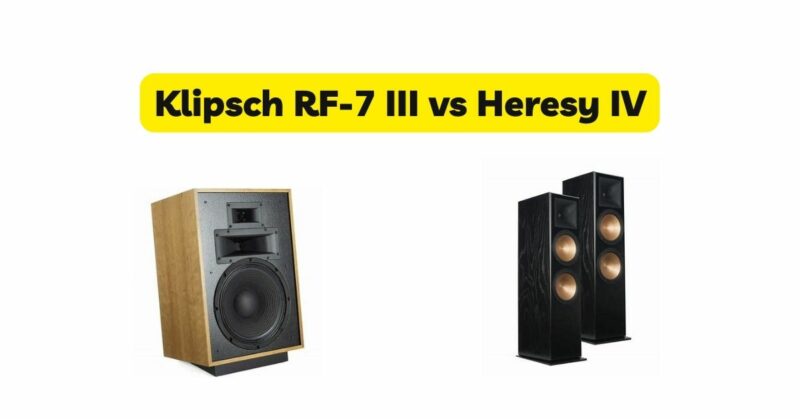Klipsch is a revered name in the audio industry, known for its commitment to producing high-quality speakers that deliver a captivating listening experience. In this article, we delve into a comparison between two iconic models from Klipsch: the Klipsch RF-7 III and the Klipsch Heresy IV. By examining their design, performance, features, and sonic characteristics, we aim to provide a comprehensive analysis of these exceptional speakers and shed light on the clash between heritage and modernity.
I. Design and Construction
Both the Klipsch RF-7 III and Klipsch Heresy IV showcase Klipsch’s dedication to craftsmanship and aesthetics. The RF-7 III, as part of the Reference Series, embodies a modern design with clean lines, copper accents, and a furniture-grade wood veneer finish. On the other hand, the Klipsch Heresy IV pays homage to Klipsch’s heritage, featuring a classic design with a slant-front cabinet, exposed drivers, and a choice of wood veneer or custom finishes.In terms of construction, both speakers are meticulously built using high-quality materials. The RF-7 III incorporates internal bracing and cabinet design enhancements for reduced resonance and improved rigidity, resulting in cleaner sound reproduction. The Heresy IV, on the other hand, embraces the classic “box” design and utilizes solid MDF construction for enhanced durability and acoustic performance.
II. Performance and Sound Quality
The Klipsch RF-7 III and Klipsch Heresy IV offer distinct sound signatures and performance characteristics. The RF-7 III boasts a three-way design, featuring a pair of 10-inch woofers, a 6.5-inch midrange driver, and a 1.75-inch titanium compression driver coupled with a Tractrix horn. This driver configuration delivers dynamic and detailed sound reproduction, characterized by Klipsch’s hallmark efficiency and clarity. The RF-7 III offers robust bass response, smooth midrange, and extended high frequencies.In contrast, the Klipsch Heresy IV is a two-way speaker, featuring a 12-inch woofer and a 1-inch titanium compression driver coupled with a square Tractrix horn. The Heresy IV offers a more vintage sound, with a focus on midrange presence and punch. It delivers a unique, lively soundstage with excellent imaging and precise vocal reproduction, making it well-suited for both music listening and home theater applications.
III. Technology and Features
Both the Klipsch RF-7 III and Klipsch Heresy IV incorporate advanced technologies and features that contribute to their exceptional performance. The RF-7 III benefits from Klipsch’s Tractrix horn design, ensuring precise and efficient sound dispersion while minimizing distortion. The Cerametallic woofers, coupled with the compression driver, enable accurate and controlled bass reproduction and smooth midrange performance.The Heresy IV also utilizes Klipsch’s Tractrix horn technology, providing controlled directivity and high-frequency dispersion. It features a rear-mounted passive radiator that enhances bass response and extends low-frequency performance. The Heresy IV also offers bi-wiring and bi-amping capabilities, allowing for further optimization of the speaker’s performance.
IV. Listening Experience and Room Placement
The Klipsch RF-7 III and Klipsch Heresy IV offer distinctive listening experiences based on their design and sound characteristics. The RF-7 III is well-suited for medium to large rooms, filling the space with its impactful sound signature. Its efficiency and power handling make it an excellent choice for both stereo music listening and immersive home theater setups.The Klipsch Heresy IV, with its more compact size and focused soundstage, excels in smaller rooms or as near-field monitors. It offers an intimate listening experience, allowing for a closer connection to the music and a sense of immediacy. The Heresy IV can also be used as front speakers in a home theater system or as surround speakers, providing seamless integration and enveloping sound.When it comes to room placement, both speakers benefit from careful positioning to optimize their performance. Experimenting with speaker placement, toe-in angles, and distance from walls can fine-tune the imaging, soundstage, and overall balance of each speaker.
V. Price and Value
The Klipsch RF-7 III and Klipsch Heresy IV represent different price points within Klipsch’s speaker lineup. The RF-7 III, being the flagship model, carries a higher price tag due to its advanced features, larger size, and improved performance. The Heresy IV, while not as expensive as the RF-7 III, still offers exceptional value for those seeking a piece of Klipsch’s heritage and renowned sound quality.
Conclusion
In conclusion, the Klipsch RF-7 III and Klipsch Heresy IV are both exceptional speakers that cater to different preferences and listening environments. The RF-7 III embodies modernity, with its sleek design, three-way configuration, and powerful sound reproduction. On the other hand, the Heresy IV pays tribute to Klipsch’s heritage, offering a classic design, two-way configuration, and a unique, lively sound signature.The choice between the Klipsch RF-7 III and Klipsch Heresy IV ultimately comes down to personal preference, room size, and the desired sonic characteristics. The RF-7 III excels in larger rooms and home theater setups, delivering immersive and impactful sound. The Heresy IV shines in smaller rooms or as near-field monitors, providing a more intimate and engaging listening experience.Whichever speaker you choose, both the Klipsch RF-7 III and Klipsch Heresy IV exemplify Klipsch’s commitment to craftsmanship, performance, and the art of reproducing music. They are both worthy contenders in the realm of high-quality speakers, allowing you to elevate your audio experience and enjoy your favorite music and movies with exceptional clarity, detail, and emotion.

